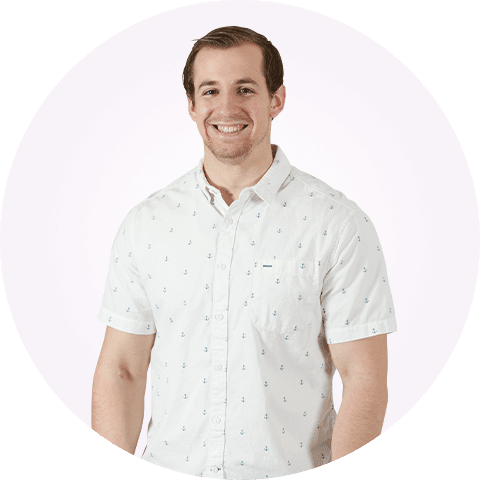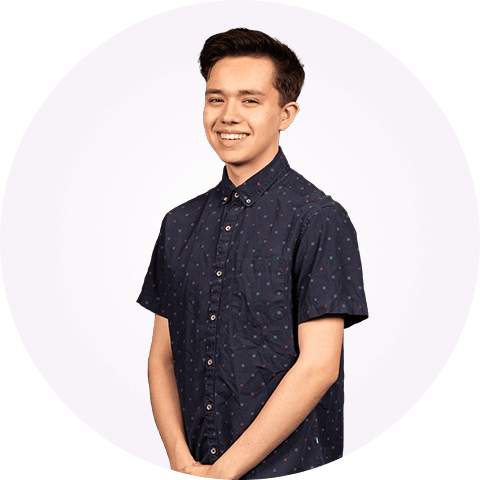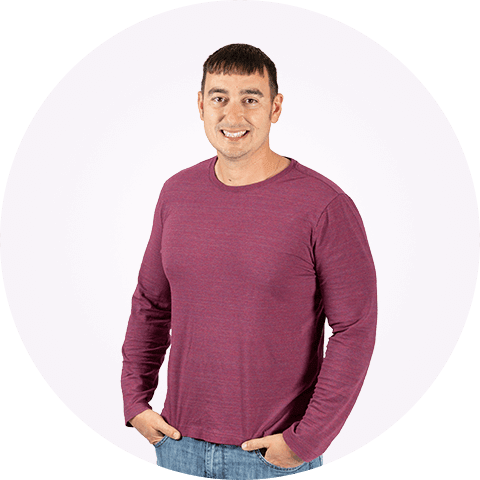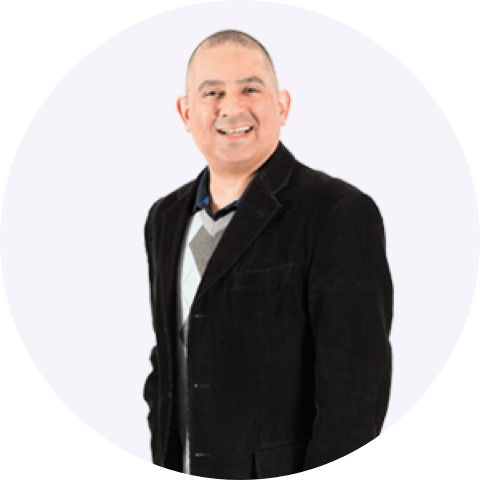Real People. Real Stories
As a patient with hemophilia A, it can be helpful to hear from people who share similar experiences with you. Knowing that they've been through it too can make a difference. Meet Dylan, Brett, Aaron, and Luis. Four real people living with hemophilia A—all treating with ADYNOVATE.
Click on each picture to see the patient story.








Growing up with hemophilia A is something Dylan has taken in stride. His condition doesn’t stop him from dreaming big and looking towards the future.
Brett, an actual patient, has never let his condition slow him down, whether he's coaching softball, being a parent, or enjoying himself on the golf course. Hemophilia A is just a piece of Brett, not all of him.
Brett: a husband, father, golfer, and coach talks about managing his hemophilia A
When did you find out you had hemophilia A?
My parents had me tested right after I was born because my cousin had it. From that moment on, they treated me with kid gloves. They watched over me carefully for signs that I might be bleeding, but I didn't need my first factor VIII infusion until later when our family got into a car accident. Although no one was injured, my parents took me to a children's hospital to get checked out as a precautionary measure and to have an infusion. What a lasting impression that hospital has had on us. Even after all this time, I'm still treated at the same hemophilia treatment center. I'm very happy with my doctor and treatment team because they take the time to listen, they treat me like a partner in my health, and they're on top of treatments and the latest research.
What was growing up with hemophilia A like for you?
I was a kid who always wanted to do the things that I couldn't or shouldn't do and...I confess, I was a little pistol. Very headstrong. Whenever I faced an obstacle, I was bound and determined to use my resources to figure out a possible solution.
At the age of eight, after my parents and I talked to my doctor and he gave me the okay, I took up golf. That being said, certain activities, including golf, aren't for everyone with hemophilia A, which is why you should always talk to your doctor. My doctor told us that if anyone even suspected that I might be injured from playing golf, I should call him or go to a treatment center immediately for care. By the age of 18, I had won six Junior League Golf tournaments. I got to play all over the world, and I met some great people in the process. Over those important childhood years, I attended a hemophilia camp where I learned to self-infuse–which gave me a sense of independence.
What has your hemophilia A treatment journey been like?
About three years ago, I was recruited to coach a softball team for my company. My doctor gave me his permission first of course, and he reminded me that I needed to be cautious. But I was noticing that I was having a lot of bleeds, so I discussed it with my doctor again, and he recommended that I switch from on-demand, to prophy treatment. Always consult with your doctor to determine which treatment regimen is right for you.
I had fewer bleeds, which showed that my doctor and I had made the right decision for me regarding my treatment plan. I also tracked my bleeds through an app on my smart phone. Yes, there's an app for that.
How did you find out about ADYNOVATE®?
I strive for zero bleeds, so my doctor called me to talk about ADYNOVATE. After discussing the benefits and risks, including the common side effects of headache, diarrhea, rash, nausea, dizziness and hives, he thought it would be a good option for me because of the extended half-life and twice-weekly dosing schedule.1 So I was really interested and wanted to hear more because I was familiar with Takeda's reputation in the bleeding disorders community. Since I have been on ADYNOVATE, I have not had a bleed. Keep in mind, though, this is just my personal experience. You might have a different experience. That's why it is important to talk to your doctor about any questions you have about a product's safety and efficacy, your treatment plan and infusion training.
I like the simple dosing schedule of infusing on the same days every week, twice a week.1 For me, my doctor prescribed that I take ADYNOVATE on Mondays and Thursdays and continue to see him on a regular basis. I like infusing in the morning, because that's how I like to start my day. There are days, though, when trying to get to work on time with our rambunctious kids, God love 'em, is a little uh…hectic…I try to set aside 10 minutes to mix and infuse.
What is your support system like?
My parents raised me to be self-reliant and proactive about my health, which prepared me to always try to take good care of myself. Now, my wife, Landi, and I live in Florida with our two children, Landen and Delani. So now I feel I owe it to them, too, to take care of myself.
One of the things I really like about Takeda is the assistance and support services I've received through the Hematology Support Center. Also, because I was eligible, I have received co-pay assistance, which I really appreciate.
This is Brett's experience, not everyone will have the same experience on ADYNOVATE.
SELECTED IMPORTANT RISK INFORMATION
What should I tell my HCP before using ADYNOVATE?
Tell your HCP if you:- Have or have had any medical problems.
- Take any medicines, including prescription and non-prescription medicines, such as over-the-counter medicines, supplements or herbal remedies.
- Have any allergies, including allergies to mice or hamsters.
- Are breastfeeding. It is not known if ADYNOVATE passes into your milk and if it can harm your baby.
- Are or become pregnant. It is not known if ADYNOVATE may harm your unborn baby.
- Have been told that you have inhibitors to factor VIII (because ADYNOVATE may not work for you).
See Detailed Important Risk Information below.
With a long family history of hemophilia A, Aaron grew up knowing a lot about his condition. In fact, his grandfather, a scientist living with severe hemophilia A, helped develop the first FVIII concentrate, and has been a big inspiration for Aaron.
Aaron uses his strong support system, family history, and ADYNOVATE to manage his hemophilia A and live life to the fullest.
You have quite a family history with hemophilia A, can you share a little bit about that?
I've always been interested in how things work and how to make them work better. Actually, that's something I have in common with my grandfather. We both combined the two common things in my family: science and hemophilia. My grandfather, Murray Thelin, was a scientist living with severe hemophilia A. His lifelong struggle inspired him to work on a treatment, and he developed the first factor VIII concentrate. He's a special person in our family, especially with his legacy and the contribution he's made to all of our well-being, and I really wish I could've met him. But he helped fuel my childhood dream: to become a biochemist and someday cure hemophilia.
When did you find out you had hemophilia A?
My severe hemophilia A was detected before I was born. I was tested for hemophilia as soon as the doctor found out that I was a boy because my mom is a carrier. However, I did not have a bleed until I was about nine months old. My parents noticed that I was crawling unusually, not on my hands and knees, but with my elbows. They brought me to the emergency room and learned that I was bleeding. Fortunately, I didn't grow up spending much time in the emergency room.
What was growing up with hemophilia A like for you?
I used to have three to five bleeds a month. At the start of every school year, my parents and I would meet with the school nurse to talk about my hemophilia A and to let the nurse know what to expect. Some teachers tended to be overly cautious, but for the most part they'd let me play with the other kids.
Some kids teased me, but most didn't treat me differently, and we had fun together. I think most of the kids knew I had hemophilia but were too young to understand what it meant. When I came to school on crutches because of a bleed, kids would ask me if I broke my foot. They didn't understand when I said that I woke up like that. Because I was only on crutches for about a week at a time, some kids accused me of faking an injury to get out of gym. My disorder required thick skin, but I used big words to explain what was going on, and that often did the trick. This all got better as everyone grew up.
By high school, I wasn't teased so much. I was open about my hemophilia A, and the fact that I gave myself IVs became my go-to when teachers asked students to “share something interesting about yourself.” I'd learned how to infuse myself when I was seven years old at hemophilia camp and I've been doing it entirely on my own since I was eight or nine. If you're not already self-infusing, be sure to ask your healthcare team about getting trained by your HTC or healthcare professional.
Hemophilia camp was a family tradition every summer since I was born. I loved camp; it was better than Christmas! Since my sisters and I are close in age, we would be in a lot of the same groups. It was fun to have people I knew, but it was a special treat to play with other boys my age. Camp helped all of us understand hemophilia and talk to other people who were in our shoes.
How did you find out about ADYNOVATE?
There have been different phases in my life when I've hated hemophilia and others when I was okay with hemophilia but hated daily prophylaxis. I often thought of prophylaxis treatment as a chore—and who likes doing chores? But I knew the importance of treating and never skipped it.
So, I was interested in learning more from my doctor when I heard about the extended half-life of ADYNOVATE® that I could take on the same two days every week. ADYNOVATE is an injectable medicine that is used to help treat and control bleeding in children and adults with hemophilia A. ADYNOVATE can reduce the number of bleeding episodes when used regularly, which is called prophylaxis. Also, ADYNOVATE is not for people who are allergic to mice or hamster protein, or who are allergic to any ingredients in ADYNOVATE or ADVATE® [Antihemophilic Factor (Recombinant)].
What is your support system like?
My family has always been supportive and encouraging. My four sisters were never jealous of the extra attention I received because of hemophilia. They were so helpful whenever I had a bleed, like bringing me ice packs when I was stuck on the couch. When I was in middle school, my sister and I developed a tradition. She's right-handed and I'm left-handed, so after I infused at my IV site, she would hold pressure for me. We'd sit next to each other eating our cereal, me with my left hand and her with her right hand. My mom encouraged me to stay active using the National Hemophilia Foundation (NHF) chart to find activities that were appropriate for me. Always talk with your doctor to determine what activities are appropriate for you. I feel like being active while I was growing up helped me. Plus, my parents always told me to lay low, or rest, whenever I had a bleed.
My wife has also been great at supporting me. We dated in high school and I was always open about my hemophilia A. My local boys club project was to organize a fun run, called the Clot Trot, to promote hemophilia awareness. This has become an annual event around National Hemophilia Day for the past 12 years. My wife has been at all of them. She's going to be a physician assistant, and she's known quite a bit about hemophilia for a long time. Once we started dating seriously, she wanted to know what hemophilia would mean for us. She asked me questions that I'd answer honestly, like, “What is hemophilia like every day? What are the negatives of hemophilia? If we have kids, would they have hemophilia?” She's even volunteered at camps and national hemophilia events.
Growing up in Peru, Luis treated most of his hemophilia A bleeds by applying ice and waiting for the injury to heal itself. On occasion, his family members had to donate blood.
Luis, a father and management professional with severe hemophilia A
What was life like growing up with hemophilia A in Peru?
When I wasn’t in the midst of or recovering from a bleed, I tried to live to the max, taking advantage of every second of good health. I did this because I truly never knew when the next bleed would occur. As you can imagine, I missed a lot of school days and birthday parties, and I spent many holidays in hospitals and ERs.
Apart from my hemophilia A, I had a very comfortable life in Peru. My father was a Doctor of Economics and quite successful, and my mother was always sweet and loving. They encouraged me to pursue academics, and I entered a prestigious university at the age of 16. While my friends and mother celebrated my admission, my father said, "Luis, you haven't accomplished anything yet. Now the hard work begins." I entered into a very difficult course of study, but because of a major bleed, I had to discontinue my education. At that time, I would treat my bleeds with rest, ice, and more rest. Every joint in my body has had a bleed, and some were disabling. I was frustrated, watching my friends continue with their educations and move ahead with their lives while I never knew when the next bleed would occur or how severe it would be.
You’ve been involved with advocacy for the bleeding disorders community. Tell us about that.
Before leaving Peru, I was active in a hemophilia advocacy group. We were able to organize the first national census to identify individuals from all over Peru affected by bleeding disorders and register them. We registered over 500 people.
How did you get started with ADYNOVATE?
My hematologist talked to me about ADYNOVATE. He said that ADYNOVATE has a longer circulating half-life than ADVATE and explained that I could infuse twice a week on the same days each week.
Together, we decided I would make the transition to treating prophylactically with ADYNOVATE. I really like the infusion schedule of infusing the same two days each week.
What’s life like for you today?
Since coming to the US, I have been able to have a nice life. I'm now married. My wife and I bought a house, and we now have a son named Ian. I am in a management position at a well-known international corporation. I graduated magna cum laude from a well-known university with a degree in international business, and recently, I graduated with honors from a professional MBA program that was ranked number 9 in the world in 2020. I'm proud of fulfilling the dream that began when I was 16, and by the way, my father was right. It WAS hard work!





